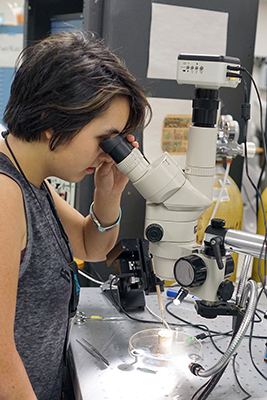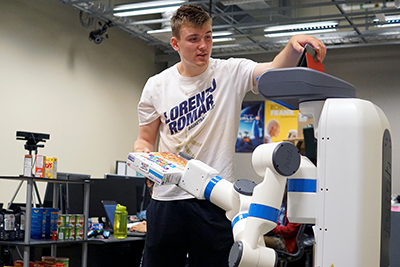Summer Study: What Do Phase II Scholars Do?
Phase II Scholars return to the UW Seattle campus for their second Summer Study. They meet the Phase I Scholars, learn about college life and career preparation, and participate in a one-week workshop with postsecondary instructors.
Neurobiology Workshop

In the neurobiology Phase II workshop, the Scholars studied the reaction of embryonic mice hearts when drugs were used. Scholars also observed how the neurons from the cockroach leg responded when the Scholars pushed down on the leg hairs. The purposes of the experiments were to study the action potential of a neuron and how the nerves react when drugs are added to the system or when sensory nerves are activated.
During this workshop, the Scholars broke up into two groups. One group worked in the cockroach lab while the other worked in the embryonic mouse heart lab. In the cockroach lab, Scholars were able to analyze data recorded from manipulating the hairs on a cockroach leg. The cockroach legs were manipulated with a mechanical probe and viewed using a microscope. Data collected was analyzed to see how the neurons responded to touch. In the mouse heart lab, the Scholars focused on the reaction of the embryonic mouse heart when the two drugs nicotine and ACEA (Arachidonyl-2’-chloroethylamide) were applied. Scholars were able to witness how the heart reacted using a microscope and computer software.
The Phase II Scholars gained a lot of knowledge on working in a lab and conducting neurobiology experiments. Ryan enjoyed learning “more about the dissection process,” while they dissected the hearts from embryonic mice. Neurological pathways and the structure of neurons were the most important things learned by Cameron and Kyleelynn.
We appreciate Professor Marti Bosma and graduate students Aris, Chris, Comron, Josh, Kelly, Nikki, and Lauren for working with Scholars Cameron, Jayda, Kyleelynn, Naomi, Ryan, Teresa, and Z in this lab.
We would also like to thank Ron Killman for setting up the scopes, Dave Hurley and Mara Kilpatrick for helping in the biology study area, and Alex Hansen for helping with access.
Robotics Workshop

Do you like robots? Are you wondering what robots can do in the lives of people with disabilities? Well, you’re in luck because this article covers the DO-IT Phase II Robotics workshop at the University of Washington. Maya Cakmak is an assistant professor at the University of Washington, and was the lead staff for the robotics workshop. She teaches students how to program robots in order to help people with disabilities live independently. Justin Huang, a 5th year Ph.D student, also helps with this process.
The students in this workshop had to create a robot that helps people at the grocery store. The robot is designed to do a plethora of things including picking items off a shelf and offering different options to customers who were interested in a certain product. The Phase II Scholars had to do just that. We used Codeit, software used to program robots to do specific functions, to make the robot’s arm move and perform our desired tasks. With help from instructors and hands on learning from peers, the students designed a robot that showed how robots can be a benefit in our society.
Watch a video about the workshop online.
The Phase II Scholars who participated in the robotics workshop were Adrian, Rochelle, Serena, Micayla, Takashi, Jacky, and Jarrod.